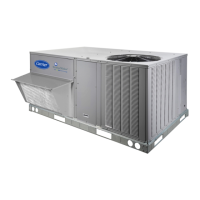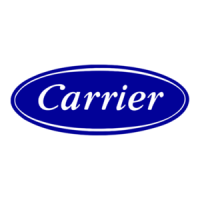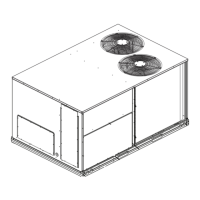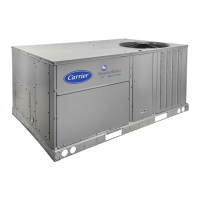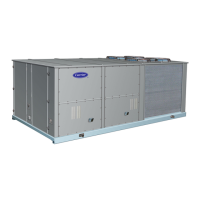2
System Pilott -- Communication Space Sensor 9...........
Accessories 9.......................................
Programming Operating Schedules 10....................
SERVICE TEST 10....................................
Independent Outputs 10...............................
Fan Test 10.........................................
Cooling Test 11.....................................
Heating Test 11......................................
Automatic Test 11....................................
THIRD PARTY CONTROL 12..........................
Cooling/Heating Control 12............................
Dehumidification Control 12...........................
Remote Occupancy 12................................
Remote Shutdown 12.................................
Alarm Output 12.....................................
Economizer Damper Control 12.........................
CONTROLS OPERATION 12...........................
Display Configuration 12..............................
Unit Configuration 12.................................
General Operation 13.................................
Demand Determination 13.............................
Occupancy Determination 15...........................
Indoor Fan Operation 16...............................
Cooling Operation 16.................................
Optional Humidi--MiZer
R
Dehumidification System 17......
Indoor Fan Based Dehumidification 21...................
Heating Operation 21.................................
Supply Air Tempering 22..............................
Two Position Damper Operation 22......................
Economizer Operation 22..............................
Power Exhaust 24....................................
Indoor Air Quality (IAQ) 25............................
Pre--occupancy Purge 26...............................
Temperature Compensated Start 26.......................
Linkage 26.........................................
Carrier Comfort Network
R
(CCN) Operation 26............
BACnet Network Operation 26.........................
Alarm Handling 27...................................
TROUBLESHOOTING 27..............................
Complete Unit Stoppage 27............................
Restart Procedure 27..................................
Faults and Alerts 27..................................
Control Module Communication 34......................
Communication Failures 34............................
Cooling Troubleshooting 35............................
Humidi--MiZer System Troubleshooting 36................
Economizer Troubleshooting 37.........................
Heating Troubleshooting 38............................
Phase Protection 41..................................
Thermistor Troubleshooting 41.........................
Sensor Trim 41......................................
Transducer Troubleshooting 41.........................
MAJOR S YSTEM COMPONENTS 46....................
General 46.........................................
Main Base Board (MBB) 54............................
Integrated Gas Control (IGC) Board 56...................
Protective Devices 57.................................
Space Mounted Sensors 57.............................
Carrier Comfort Network
R
(CCN) Interface 59.............
APPENDIX A: SystemVut Controller Display 61...........
APPENDIX B: SystemVu Controller Text Point Reference 83...
APPENDIX C: Navigatort Display 84....................
APPENDIX D: SystemVu Controller CCN Tables 95..........
APPENDIX E: BACnet Points List 119....................
CONTROL SET POINT AND CONFIGURATION LOG 132...
UNIT START -- UP CHECKLIST 143......................
SAFETY CONSIDERATIONS
Installation and servicing of air-conditioning equipment can be
hazardous due to system pressure and electrical components. Only
trained and qualified service personnel should install, repair, or
service air-conditioning equipment. Untrained personnel can
perform the basic maintenance functions of replacing filters.
Trained service personnel should perform all other operations.
When working on air-conditioning equipment, observe precautions in
the literature, tags and labels attached to the unit, and other safety
precautions that may apply. Follow all safety codes. W ear safety
glasses and wor k gl oves. Use quenching clot h for unbrazing
operations. Have fire ext inguishers available for all brazing operations.
Follow all safety codes. Wear safety glasses and work gloves. Have
fire extinguisher available. Read these instructions thoroughly and
follow all warnings or cautions attached to the unit. Consult local
building codes and National Electrical Code (NEC) for special
requirements.
Recognize safety information. This is the safety--alert symbol
.
When you see this symbol on the unit and in instructions or
manuals, be alert to the potential for personal injury.
Unders t a nd the signa l words DANGER, WARNING, and CAUTION.
Thes e words are use d with the saf e t y--ale r t symbol. DANGER
identifies the most serious hazards which will result i n se vere personal
injury or death. WARNING signifies a hazard which could result in
personal injur y or de ath. CAUTI O N i s used to identif y unsa f e
practices which may re sult i n minor personal inj ury or produc t and
property dam age. NOTE is use d to highli ght suggestions which will
result in enhanced installation, reliability , or operation.
ELECTRICAL SHOCK HAZARD
Failure to follow this warning could cause personal injury
or death.
Before performing service or maintenance operations on
unit, turn off main power switch to unit and install lockout
tag. Ensure electrical service to rooftop unit agrees with
voltage and amperage listed on the unit rating plate.
!
WARNING

